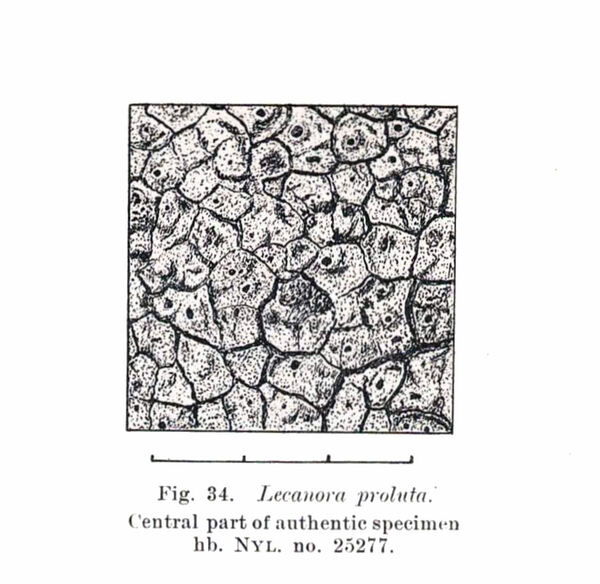Aspicilia proluta (Nyl.) Hue
Nouv. Arch. Mus. Hist. Nat., Paris, 5 sér., 2, 1: 101, 1912 (1910).. Basionym: Lecanora caesiocinerea f. proluta Nyl. - Lich. Pyren. Orient. Obs. Nov.: 8, 1891.
Synonyms: Aspicilia submersa (Lamy) Hue; Circinaria proluta (Nyl.); Lecanora proluta (Nyl.) Zahlbr.; Lecanora subdepressa var. submersa Lamy; Lecanora submersa (Lamy) Zahlbr.
Distribution: N - Lig (Paukov & al. 2019).
Description: Thallus crustose, episubstratic, rimose-areolate, 0.1-0.3 mm thick, grey to bluish grey, forming well-delimited patches, usually without a dark prothallus. Areoles to 0.8 mm wide, angular or partly rounded, usually flat. Cortex overlain by a thin epinecral layer, without crystals; medulla white, I-. Apothecia lecanorine-aspicilioid, scarce to abundant, immersed in the areoles, 1-3 per areole, 0.15-0.25 mm across, round, with a concave, black, epruinose disc, and a thin, not prominent thalline margin. Epithecium grey-green, 8-15 μm thick, N+ emerald green, usually without crystals; hymenium colourless, 100-125 μm high, I+ blue turning reddish brown; paraphyses sparingly branched, anastomosing and submoniliform in upper part, the apical cells 2-2.5 μm wide; hypothecium colourless, c. 45 μm high, I+ blue. Asci 8-spored, clavate, the thin outer coat K/I+ blue, the wall and apical dome K/I-, with 1-2-seriately arranged spores. Ascospores 1-celled, hyaline, ellipsoid, 22-25 x 15-17 μm, thin-walled. Pycnidia pyriform, the wall colourless except around the ostiole. Conidia short-filiform, straight to slightly curved, 7-9 μm long. Photobiont chlorococcoid. Spot tests: cortex and medulla K+ yellow, C-, KC-, P+ orange. Chemistry: stictic acid complex. Note: on periodically flooded siliceous rocks; a poorly known species described from the Pyrenees, which needs further study. Its distinction from the more xerophilous A. subdepressa is still an open problem (see Paukov & al. 2019, Roux & coll. 2020).
Growth form: Crustose
Substrata: rocks
Photobiont: green algae other than Trentepohlia
Reproductive strategy: mainly sexual
Poorly known taxon in need of further study
Commonnes-rarity: (info)
Alpine belt: absent
Subalpine belt: absent
Oromediterranean belt: absent
Montane belt: very rare
Submediterranean belt: very rare
Padanian area: absent
Humid submediterranean belt: absent
Humid mediterranean belt: absent
Dry mediterranean belt: absent

Predictive model
Herbarium samples
Growth form: Crustose
Substrata: rocks
Photobiont: green algae other than Trentepohlia
Reproductive strategy: mainly sexual
Poorly known taxon in need of further study
Commonnes-rarity: (info)
Alpine belt: absent
Subalpine belt: absent
Oromediterranean belt: absent
Montane belt: very rare
Submediterranean belt: very rare
Padanian area: absent
Humid submediterranean belt: absent
Humid mediterranean belt: absent
Dry mediterranean belt: absent

Predictive model
| Herbarium samples |
 Index Fungorum
Index Fungorum
 GBIF
GBIF


